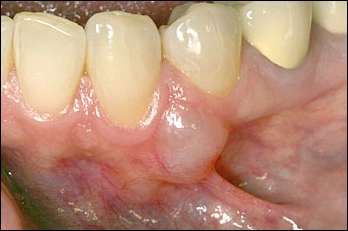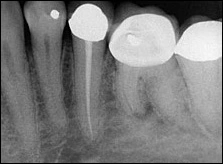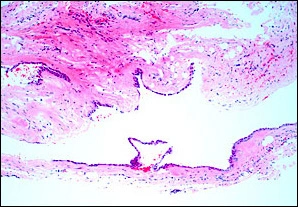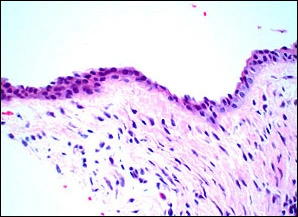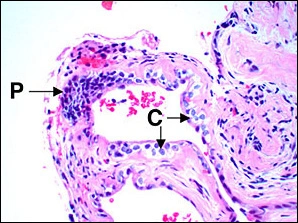A Solitary Gingival Nodule
Case Challenge Number: 28
Diagnostic Information
Oral Findings Intraoral examination revealed a one centimeter in diameter, fluctuant, translucent nodule located on the facial gingiva and alveolar mucosa between her mandibular left canine and first premolar (Figure 1). The nodule was slightly tender to palpation. Vitality testing and periodontal probing depths of the adjacent teeth were all within normal limits.
Figure 1. A slightly translucent nodular mass of the facial gingiva between the mandibular left canine and first premolar.
Radiographic Findings
A periapical radiograph of the area was obtained, but no obvious radiographic changes could be identified (Figure 2).
Figure 2. A periapical radiograph of the area failed to show any associated bony changes in the area of the lesion.
Medical History A review of the patient’s past medical history was significant for gastroesophageal reflux disease (GERD) and inflammatory bowel disease. She took lansoprazole (a proton pump inhibitor) daily for control of her GERD. Excisional Biopsy and Photomicrograph
A biopsy of the mass was performed under local anesthesia. Upon incision, the swelling deflated and released a small amount of watery fluid. Multiple small, irregular fragments of tissue were removed and submitted for microscopic examination.
The microscopic sections showed a cavity that was lined by a thin layer of epithelial cells (Figure 3). This lining was only one to two cells thick in most areas, but it also demonstrated occasional plaque-like epithelial thickenings (Figure 4).
Figure 3. Low-power photomicrograph showing a central cavity lined by a thin layer of epithelial cells. (Hematoxylin and eosin stain)
Figure 4. Medium-power photomicrograph showing a thin epithelial lining that is only one to two cells thick. (Hematoxylin and eosin stain)
In some areas the lining included cells with a clear, vacuolated cytoplasm (Figure 5). The cavity was surrounded by a wall of fibrous connective tissue with minimal inflammation.
Figure 5. High-power photomicrograph showing the thin epithelial lining with a small plaque-like thickening (P). Shorter arrows (C) point out several glycogen-rich clear cells. (Hematoxylin and eosin stain)


